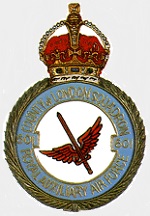Hobby Master HA1703 RAF Bell P-39Q Airacobra Fighter - No.601 Squadron "County of London", Duxford, England, October 1941 (1:72 Scale)
"Why should we have a navy at all? There are no enemies for it to fight except apparently the Army Air Force."
- General Carl Spaatz, Commander of the US 8th Army Air Force, after WWII
 The P-39 was one of America's first-line pursuit planes in December 1941. It made its initial flight in April 1939 at Wright Field and by the time of the Pearl Harbor attack, nearly 600 had been built. Its unique engine location behind the cockpit caused some pilot concern, but this proved to be no more of a hazard in a crash landing than with an engine located forward of the cockpit. However, the P-39's spin characteristics could be quite a problem if recovery techniques were ignored.
The P-39 was one of America's first-line pursuit planes in December 1941. It made its initial flight in April 1939 at Wright Field and by the time of the Pearl Harbor attack, nearly 600 had been built. Its unique engine location behind the cockpit caused some pilot concern, but this proved to be no more of a hazard in a crash landing than with an engine located forward of the cockpit. However, the P-39's spin characteristics could be quite a problem if recovery techniques were ignored.
The Airacobra saw combat throughout the world, particularly in the Southwest Pacific, Mediterranean and Russian theaters. Because its engine was not equipped with a supercharger, the P-39 performed best below 17,000 feet altitude, and it often was used at lower altitudes for such missions as ground strafing. When P-39 production ended in August 1944, Bell had built 9,584 Airacobras, of which 4,773 had been allotted to the Soviet Union. Russian pilots, in particular, liked the cannon-armed P-39 for its ground attack capability. Other P-39s served with French and British forces.
This particular 1:72 scale replica of a P-39Q Airacobra fighter served with the 601 Squadron "County of London", then deployed to Duxford, England, during October 1941. Sold Out!
Dimensions:
Wingspan: 5-3/4-inches
Length: 5-inches
Release Date: March 2008
 Historical Account: "County of London" - No. 601 Squadron was formed at Northolt on October 14th, 1925, as a light bomber unit of the Auxiliary Air Force. A nucleus of permanent staff was posted to the squadron and on December 4th the first Auxiliary personnel were enlisted. Flying did not begin until May 1926 and it was the following year before the Avro 504Ks were supplemented by D.H.9A light bombers. In January 1927, the squadron moved to Hendon, which was its base up to the outbreak of war, apart from a few days during the Munich crisis in September 1938. In November 1929 Waptis began to arrive and a year later had replaced all the D.H.9As. These were in turn replaced by Harts by June 1933 and on July 1st, 1934, the squadron was redesignated a fighter unit. The Harts were retained until replaced by Demons in August 1937. In November 1938, No. 601 converted to Guantlet single-seat fighters, but in January 1939 began to receive Blenheims. It was with these that fighter patrols began when World War Two broke out in September 1939 but in March 1940 the squadron had converted to Hurricanes. During the German invasion of France, a detachment operated from French soil for a week, followed by defensive duties during the Battle of Britain while based in southern England.
Historical Account: "County of London" - No. 601 Squadron was formed at Northolt on October 14th, 1925, as a light bomber unit of the Auxiliary Air Force. A nucleus of permanent staff was posted to the squadron and on December 4th the first Auxiliary personnel were enlisted. Flying did not begin until May 1926 and it was the following year before the Avro 504Ks were supplemented by D.H.9A light bombers. In January 1927, the squadron moved to Hendon, which was its base up to the outbreak of war, apart from a few days during the Munich crisis in September 1938. In November 1929 Waptis began to arrive and a year later had replaced all the D.H.9As. These were in turn replaced by Harts by June 1933 and on July 1st, 1934, the squadron was redesignated a fighter unit. The Harts were retained until replaced by Demons in August 1937. In November 1938, No. 601 converted to Guantlet single-seat fighters, but in January 1939 began to receive Blenheims. It was with these that fighter patrols began when World War Two broke out in September 1939 but in March 1940 the squadron had converted to Hurricanes. During the German invasion of France, a detachment operated from French soil for a week, followed by defensive duties during the Battle of Britain while based in southern England.
In February 1941, the squadron began taking part in offensive sweeps over northern France which continued until August, when re-equipment with Airacobras began. These proved useless and were discarded in favor of Spitfires in March 1942, but after only a few minor operations. In April the squadron sailed for the Middle East and re-assembled in Egypt on June 25th. Fighter sweeps over the Western Desert started a few days later and after the rout of the Afrika Korps at El Alamein, the squadron moved westwards to Tunisia, where it was present at the end of the North African campaign in May 1943. Next month, it flew to Malta to cover the Allied landings in Sicily moving into captured airfields in mid-July. In October, No. 601 moved to Italy, where it spent the rest of the war flying ground attack missions in support of the Allied armies. On August 14th, 1945, the squadron was disbanded.


